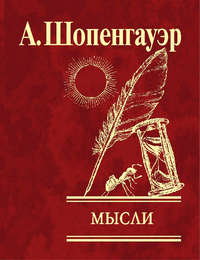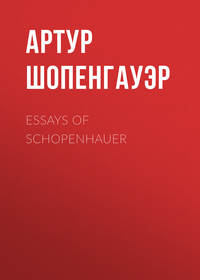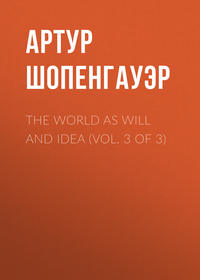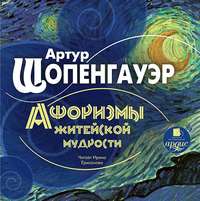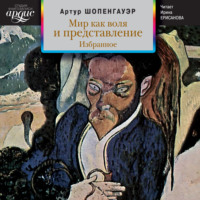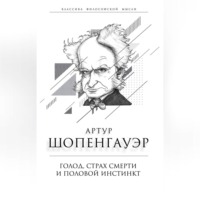 полная версия
полная версияThe World as Will and Idea (Vol. 2 of 3)
If, on the other hand, we compare two judgments with the intention of bringing out the relation which the subjects of both may have to each other, we must take as the common measure their predicate. This will accordingly be here the middle, and must therefore be the same in both judgments. Hence arises the second figure. In it the relation of two subjects to each other is determined by that which they have as their common predicate. But this relation can only have significance if the same predicate is attributed to the one subject and denied of the other, for thus it becomes an essential ground of distinction between the two. For if it were attributed to both the subjects this could decide nothing as to their relation to each other, for almost every predicate belongs to innumerable subjects. Still less would it decide this relation if the predicate were denied of both the subjects. From this follows the fundamental characteristic of the second figure, that the premisses must be of opposite quality; the one must affirm and the other deny. Therefore here the principal rule is: Sit altera negans; the corollary of which is: E meris affirmativis nihil sequitur; a rule which is sometimes transgressed in a loose argument obscured by many parenthetical propositions. The course of thought which this figure exhibits distinctly appears from what has been said. It is the investigation of two kinds of things with the view of distinguishing them, thus of establishing that they are not of the same species; which is here decided by showing that a certain property is essential to the one kind, which the other lacks. That this course of thought assumes the second figure of its own accord, and expresses itself clearly only in it, will be shown by an example:
All fishes have cold blood;No whale has cold blood:Thus no whale is a fish.In the first figure, on the other hand, this thought exhibits itself in a weak, forced, and ultimately patched-up form:
Nothing that has cold blood is a whale;All fishes have cold blood:Thus no fish is a whale,And consequently no whale is a fish.Take also an example with an affirmative minor:
No Mohamedan is a Jew;Some Turks are Jews:Therefore some Turks are not Mohamedans.As the guiding principle for this figure I therefore give, for the mood with the negative minor: Cui repugnat nota, etiam repugnat notatum; and for the mood with the affirmative minor: Notato repugnat id cui nota repugnat. Translated these may be thus combined: Two subjects which stand in opposite relations to one predicate have a negative relation to each other.
The third case is that in which we place two judgments together in order to investigate the relation of their predicates. Hence arises the third figure, in which accordingly the middle appears in both premisses as the subject. It is also here the tertium comparationis, the measure which is applied to both the conceptions which are to be investigated, or, as it were, a chemical reagent, with which we test them both in order to learn from their relation to it what relation exists between themselves. Thus, then, the conclusion declares whether a relation of subject and predicate exists between the two, and to what extent this is the case. Accordingly, what exhibits itself in this figure is reflection concerning two properties which we are inclined to regard either as incompatible, or else as inseparable, and in order to decide this we attempt to make them the predicates of one subject in two judgments. From this it results either that both properties belong to the same thing, consequently their compatibility, or else that a thing has the one but not the other, consequently their separableness. The former in all moods with two affirmative premisses, the latter in all moods with one negative; for example:
Some brutes can speak;All brutes are irrational:Therefore some irrational beings can speak.According to Kant (Die Falsche Spitzfinigkeit, § 4) this inference would only be conclusive if we added in thought: “Therefore some irrational beings are brutes.” But this seems to be here quite superfluous and by no means the natural process of thought. But in order to carry out the same process of thought directly by means of the first figure I must say:
“All brutes are irrational;Some beings that can speak are brutes,”which is clearly not the natural course of thought; indeed the conclusion which would then follow, “Some beings that can speak are irrational,” would have to be converted in order to preserve the conclusion which the third figure gives of itself, and at which the whole course of thought has aimed. Let us take another example:
All alkalis float in water;All alkalis are metals:Therefore some metals float in water.When this is transposed into the first figure the minor must be converted, and thus runs: “Some metals are alkalis.” It therefore merely asserts that some metals lie in the sphere “alkalis,” thus [Figure 1], while our actual knowledge is that all alkalis lie in the sphere “metals,” thus [Figure 2]: It follows that if the first figure is to be regarded as the only normal one, in order to think naturally we would have to think less than we know, and to think indefinitely while we know definitely. This assumption has too much against it. Thus in general it must be denied that when we draw inferences in the second and third figures we tacitly convert a proposition. On the contrary, the third, and also the second, figure exhibits just as rational a process of thought as the first. Let us now consider another example of the other class of the third figure, in which the separableness of two predicates is the result; on account of which one premiss must here be negative:
No Buddhist believes in a God;Some Buddhists are rational:Therefore some rational beings do not believe in a God.As in the examples given above the compatibility of two properties is the problem of reflection, now their separableness is its problem, which here also must be decided by comparing them with one subject and showing that one of them is present in it without the other. Thus the end is directly attained, while by means of the first figure it could only be attained indirectly. For in order to reduce the syllogism to the first figure we must convert the minor, and therefore say: “Some rational beings are Buddhists,” which would be only a faulty expression of its meaning, which really is: “Some Buddhists are yet certainly rational.”
As the guiding principle of this figure I therefore give: for the affirmative moods: Ejusdem rei notœ, modo sit altera universalis, sibi invicem sunt notœ particulares; and for the negative moods: Nota rei competens, notœ eidem repugnanti, particulariter repugnat, modo sit altera universalis. Translated: If two predicates are affirmed of one subject, and at least one of them universally, they are also affirmed of each other particularly; and, on the contrary, they are denied of each other particularly whenever one of them contradicts the subject of which the other is affirmed; provided always that either the contradiction or the affirmation be universal.
In the fourth figure the subject of the major has to be compared with the predicate of the minor; but in the conclusion they must both exchange their value and position, so that what was the subject of the major appears as the predicate of the conclusion, and what was the predicate of the minor appears as the subject of the conclusion. By this it becomes apparent that this figure is merely the first, wilfully turned upside down, and by no means the expression of a real process of thought natural to the reason.
On the other hand, the first three figures are the ectypes of three real and essentially different operations of thought. They have this in common, that they consist in the comparison of two judgments; but such a comparison only becomes fruitful when these judgments have one conception in common. If we present the premisses to our imagination under the sensible form of two rods, we can think of this conception as a clasp that links them to each other; indeed in lecturing one might provide oneself with such rods. On the other hand, the three figures are distinguished by this, that those judgments are compared either with reference to the subjects of both, or to the predicates of both, or lastly, with reference to the subject of the one and the predicate of the other. Since now every conception has the property of being subject or predicate only because it is already part of a judgment, this confirms my view that in the syllogism only judgments are primarily compared, and conceptions only because they are parts of judgments. In the comparison of two judgments, however, the essential question is, in respect of what are they compared? not by what means are they compared? The former consists of the concepts which are different in the two judgments; the latter consists of the middle, that is, the conception which is identical in both. It is therefore not the right point of view which Lambert, and indeed really Aristotle, and almost all the moderns have taken in starting from the middle in the analysis of syllogisms, and making it the principal matter and its position the essential characteristic of the syllogisms. On the contrary, its role is only secondary, and its position a consequence of the logical value of the conceptions which are really to be compared in the syllogism. These may be compared to two substances which are to be chemically tested, and the middle to the reagent by which they are tested. It therefore always takes the place which the conceptions to be compared leave vacant, and does not appear again in the conclusion. It is selected according to our knowledge of its relation to both the conceptions and its suitableness for the place it has to take up. Therefore in many cases we can change it at pleasure for another without affecting the syllogism. For example, in the syllogism:
All men are mortal;Caius is a man:I can exchange the middle “man” for “animal existence.” In the syllogism:
All diamonds are stones;All diamonds are combustible:I can exchange the middle “diamond” for “anthracite.” As an external mark by which we can recognise at once the figure of a syllogism the middle is certainly very useful. But as the fundamental characteristic of a thing which is to be explained, we must take what is essential to it; and what is essential here is, whether we place two propositions together in order to compare their predicates or their subjects, or the predicate of the one and the subject of the other.
Therefore, in order as premisses to yield a conclusion, two judgments must have a conception in common; further, they must not both be negative, nor both particular; and lastly, in the case in which the conceptions to be compared are the subjects of both, they must not both be affirmative.
The voltaic pile may be regarded as a sensible image of the syllogism. Its point of indifference, at the centre, represents the middle, which holds together the two premisses, and by virtue of which they have the power of yielding a conclusion. The two different conceptions, on the other hand, which are really what is to be compared, are represented by the two opposite poles of the pile. Only because these are brought together by means of their two conducting wires, which represent the copulas of the two judgments, is the spark emitted upon their contact – the new light of the conclusion.
Chapter XI.22 On Rhetoric
Eloquence is the faculty of awakening in others our view of a thing, or our opinion about it, of kindling in them our feeling concerning it, and thus putting them in sympathy with us. And all this by conducting the stream of our thought into their minds, through the medium of words, with such force as to carry their thought from the direction it has already taken, and sweep it along with ours in its course. The more their previous course of thought differs from ours, the greater is this achievement. From this it is easily understood how personal conviction and passion make a man eloquent; and in general, eloquence is more the gift of nature than the work of art; yet here, also, art will support nature.
In order to convince another of a truth which conflicts with an error he firmly holds, the first rule to be observed, is an easy and natural one: let the premisses come first, and the conclusion follow. Yet this rule is seldom observed, but reversed; for zeal, eagerness, and dogmatic positiveness urge us to proclaim the conclusion loudly and noisily against him who adheres to the opposed error. This easily makes him shy, and now he opposes his will to all reasons and premisses, knowing already to what conclusion they lead. Therefore we ought rather to keep the conclusion completely concealed, and only advance the premisses distinctly, fully, and in different lights. Indeed, if possible, we ought not to express the conclusion at all. It will come necessarily and regularly of its own accord into the reason of the hearers, and the conviction thus born in themselves will be all the more genuine, and will also be accompanied by self-esteem instead of shame. In difficult cases we may even assume the air of desiring to arrive at a quite opposite conclusion from that which we really have in view. An example of this is the famous speech of Antony in Shakspeare's “Julius Cæsar.”
In defending a thing many persons err by confidently advancing everything imaginable that can be said for it, mixing up together what is true, half true, and merely plausible. But the false is soon recognised, or at any rate felt, and throws suspicion also upon the cogent and true arguments which were brought forward along with it. Give then the true and weighty pure and alone, and beware of defending a truth with inadequate, and therefore, since they are set up as adequate, sophistical reasons; for the opponent upsets these, and thereby gains the appearance of having upset the truth itself which was supported by them, that is, he makes argumenta ad hominem hold good as argumenta ad rem. The Chinese go, perhaps, too far the other way, for they have the saying: “He who is eloquent and has a sharp tongue may always leave half of a sentence unspoken; and he who has right on his side may confidently yield three-tenths of his assertion.”
Chapter XII.23 On The Doctrine Of Science
From the analysis of the different functions of our intellect given in the whole of the preceding chapters, it is clear that for a correct use of it, either in a theoretical or a practical reference, the following conditions are demanded: (1.) The correct apprehension through perception of the real things taken into consideration, and of all their essential properties and relations, thus of all data. (2.) The construction of correct conceptions out of these; thus the connotation of those properties under correct abstractions, which now become the material of the subsequent thinking. (3.) The comparison of those conceptions both with the perceived object and among themselves, and with the rest of our store of conceptions, so that correct judgments, pertinent to the matter in hand, and fully comprehending and exhausting it, may proceed from them; thus the right estimation of the matter. (4.) The placing together or combination of those judgments as the premisses of syllogisms. This may be done very differently according to the choice and arrangement of the judgments, and yet the actual result of the whole operation primarily depends upon it. What is really of importance here is that from among so many possible combinations of those different judgments which have to do with the matter free deliberation should hit upon the very ones which serve the purpose and are decisive. But if in the first function, that is, in the apprehension through perception of the things and relations, any single essential point has been overlooked, the correctness of all the succeeding operations of the mind cannot prevent the result from being false; for there lie the data, the material of the whole investigation. Without the certainty that these are correctly and completely collected, one ought to abstain, in important matters, from any definite decision.
A conception is correct; a judgment is true; a body is real; and a relation is evident. A proposition of immediate certainty is an axiom. Only the fundamental principles of logic, and those of mathematics drawn a priori from intuition or perception, and finally also the law of causality, have immediate certainty. A proposition of indirect certainty is a maxim, and that by means of which it obtains its certainty is the proof. If immediate certainty is attributed to a proposition which has no such certainty, this is a petitio principii. A proposition which appeals directly to the empirical perception is an assertion: to confront it with such perception demands judgment. Empirical perception can primarily afford us only particular, not universal truths. Through manifold repetition and confirmation such truths indeed obtain a certain universality also, but it is only comparative and precarious, because it is still always open to attack. But if a proposition has absolute universality, the perception to which it appeals is not empirical but a priori. Thus Logic and Mathematics alone are absolutely certain sciences; but they really teach us only what we already knew beforehand. For they are merely explanations of that of which we are conscious a priori, the forms of our own knowledge, the one being concerned with the forms of thinking, the other with those of perceiving. Therefore we spin them entirely out of ourselves. All other scientific knowledge is empirical.
A proof proves too much if it extends to things or cases of which that which is to be proved clearly does not hold good; therefore it is refuted apagogically by these. The deductio ad absurdum properly consists in this, that we take a false assertion which has been made as the major proposition of a syllogism, then add to it a correct minor, and arrive at a conclusion which clearly contradicts facts of experience or unquestionable truths. But by some round-about way such a refutation must be possible of every false doctrine. For the defender of this will yet certainly recognise and admit some truth or other, and then the consequences of this, and on the other hand those of the false assertion, must be followed out until we arrive at two propositions which directly contradict each other. We find many examples in Plato of this beautiful artifice of genuine dialectic.
A correct hypothesis is nothing more than the true and complete expression of the present fact, which the originator of the hypothesis has intuitively apprehended in its real nature and inner connection. For it tells us only what really takes place here.
The opposition of the analytical and synthetical methods we find already indicated by Aristotle, yet perhaps first distinctly described by Proclus, who says quite correctly: “Μεθοδοι δε παραδιδονται; καλλιστη μεν ἡ δια της αναλυσεως επ᾽ αρχην ὁμολογουμενην αναγουσα το ζητουμενον; ἡν και Πλατων, ὡς φασι, Λαοδαμαντι παρεδωκεν. κ.τ.λ.” (Methodi traduntur sequentes: pulcherrima quidem ea, quæ per analysin quæsitum refert ad principium, de quo jam convenit; quam etiam Plato Laodamanti tradidisse dicitur.) “In Primum Euclidis Librum,” L. iii. Certainly the analytical method consists in referring what is given to an admitted principle; the synthetical method, on the contrary, in deduction from such a principle. They are therefore analogous to the επαγωγη and απαγωγη explained in chapter ix.; only the latter are not used to establish propositions, but always to overthrow them. The analytical method proceeds from the facts; the particular, to the principle or rule; the universal, or from the consequents to the reasons; the other conversely. Therefore it would be much more correct to call them the inductive and the deductive methods, for the customary names are unsuitable and do not fully express the things.
If a philosopher tries to begin by thinking out the methods in accordance with which he will philosophise, he is like a poet who first writes a system of æsthetics in order to poetise in accordance with it. Both of them may be compared to a man who first sings himself a tune and afterwards dances to it. The thinking mind must find its way from original tendency. Rule and application, method and achievement, must, like matter and form, be inseparable. But after we have reached the goal we may consider the path we have followed. Æsthetics and methodology are, from their nature, younger than poetry and philosophy; as grammar is younger than language, thorough bass younger than music, and logic younger than thought.
This is a fitting place to make, in passing, a remark by means of which I should like to check a growing evil while there is yet time. That Latin has ceased to be the language of all scientific investigations has the disadvantage that there is no longer an immediately common scientific literature for the whole of Europe, but national literatures. And thus every scholar is primarily limited to a much smaller public, and moreover to a public hampered with national points of view and prejudices. Then he must now learn the four principal European languages, as well as the two ancient languages. In this it will be a great assistance to him that the termini technici of all sciences (with the exception of mineralogy) are, as an inheritance from our predecessors, Latin or Greek. Therefore all nations wisely retain these. Only the Germans have hit upon the unfortunate idea of wishing to Germanise the termini technici of all the sciences. This has two great disadvantages. First, the foreign and also the German scholar is obliged to learn all the technical terms of his science twice, which, when there are many – for example, in Anatomy – is an incredibly tiresome and lengthy business. If the other nations were not in this respect wiser than the Germans, we would have the trouble of learning every terminus technicus five times. If the Germans carry this further, foreign men of learning will leave their books altogether unread; for besides this fault they are for the most part too diffuse, and are written in a careless, bad, and often affected and objectionable style, and besides are generally conceived with a rude disregard of the reader and his requirements. Secondly, those Germanised forms of the termini technici are almost throughout long, patched-up, stupidly chosen, awkward, jarring words, not clearly separated from the rest of the language, which therefore impress themselves with difficulty upon the memory, while the Greek and Latin expressions chosen by the ancient and memorable founders of the sciences possess the whole of the opposite good qualities, and easily impress themselves on the memory by their sonorous sound. What an ugly, harsh-sounding word, for instance, is “Stickstoff” instead of azot! “Verbum,” “substantiv,” “adjectiv,” are remembered and distinguished more easily than “Zeitwort,” “Nennwort,” “Beiwort,” or even “Umstandswort” instead of “adverbium.” In Anatomy it is quite unsupportable, and moreover vulgar and low. Even “Pulsader” and “Blutader” are more exposed to momentary confusion than “Arterie” and “Vene;” but utterly bewildering are such expressions as “Fruchthälter,” “Fruchtgang,” and “Fruchtleiter” instead of “uterus,” “vagina,” and “tuba Faloppii,” which yet every doctor must know, and which he will find sufficient in all European languages. In the same way “Speiche” and “Ellenbogenröhre” instead of “radius” and “ulna,” which all Europe has understood for thousands of years. Wherefore then this clumsy, confusing, drawling, and awkward Germanising? Not less objectionable is the translation of the technical terms in Logic, in which our gifted professors of philosophy are the creators of a new terminology, and almost every one of them has his own. With G. E. Schulze, for example, the subject is called “Grundbegriff,” the predicate “Beilegungsbegriff;” then there are “Beilegungsschlüsse,” “Voraussetzungsschlüsse,” and “Entgegensetzungsschlüsse;” the judgments have “Grösse,” “Beschaffenheit,” “Verhältniss,” and “Zuverlässigkeit,” i. e., quantity, quality, relation, and modality. The same perverse influence of this Germanising mania is to be found in all the sciences. The Latin and Greek expressions have the further advantage that they stamp the scientific conception as such, and distinguish it from the words of common intercourse, and the ideas which cling to them through association; while, for example, “Speisebrei” instead of chyme seems to refer to the food of little children, and “Lungensack” instead of pleura, and “Herzbeutel” instead of pericardium seem to have been invented by butchers rather than anatomists. Besides this, the most immediate necessity of learning the ancient languages depends upon the old termini technici, and they are more and more in danger of being neglected through the use of living languages in learned investigations. But if it comes to this, if the spirit of the ancients bound up with their languages disappears from a liberal education, then coarseness, insipidity, and vulgarity will take possession of the whole of literature. For the works of the ancients are the pole-star of every artistic or literary effort; if it sets they are lost. Even now we can observe from the miserable and puerile style of most writers that they have never written Latin.24 The study of the classical authors is very properly called the study of Humanity, for through it the student first becomes a man again, for he enters into the world which was still free from all the absurdities of the Middle Ages and of romanticism, which afterwards penetrated so deeply into mankind in Europe that even now every one comes into the world covered with it, and has first to strip it off simply to become a man again. Think not that your modern wisdom can ever supply the place of that initiation into manhood; ye are not, like the Greeks and Romans, born freemen, unfettered sons of nature. Ye are first the sons and heirs of the barbarous Middle Ages and of their madness, of infamous priestcraft, and of half-brutal, half-childish chivalry. Though both now gradually approach their end, yet ye cannot yet stand on your own feet. Without the school of the ancients your literature will degenerate into vulgar gossip and dull philistinism. Thus for all these reasons it is my well-intended counsel that an end be put at once to the Germanising mania condemned above.


